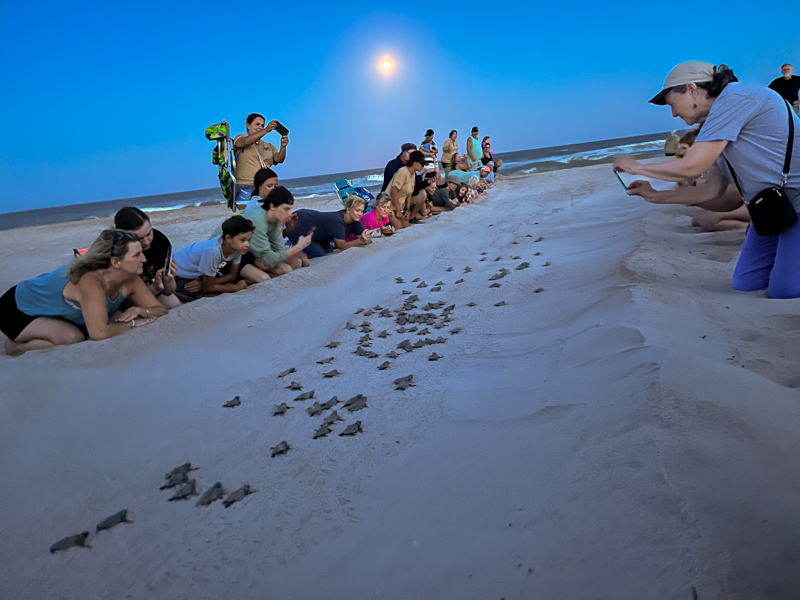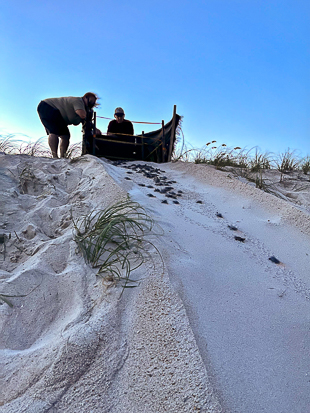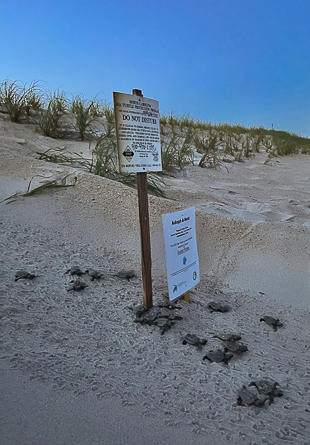Topsail Sea Turtle Trip
For immediate release ‐ September 07, 2022
Contact: Micah Beasley, 919.707.9970. Images available upon request

By Greg Skupien, Curator of the Naturalist Center
On Wednesday, August 10, staff and participants arrived on Topsail Beach on the Museum’s annual sea turtle trip. That evening we headed out to the beach and staked out our spots in front of a Loggerhead Sea Turtle nest that had been incubating for 63 days. The average incubation period for eggs in North Carolina is typically around 59 days. Chances were good that the nest would hatch soon.
We had barely set up our chairs when we heard a volunteer scream from behind us. “Lemonade! Lemonade!” she yelled. Little did we know that there was another nest nearby that had been incubating for 60 days. We quickly realized “lemonade” was the volunteers’ code word indicating that baby turtles were emerging. We raced over and found a spot along a runaway that the volunteers had swept in the sand to help direct the turtles down the beach.
Most emergences take place under cover of darkness. Fortunately for us, the last light of the day still illuminated the dunes. The moon, one day away from the last supermoon of the year, had just risen over the ocean further lighting the beach. As soon as we made it to the nest tiny turtle heads began to pop from the sand. Quickly they poured over in a “boil,” as the emergence is often called.

I tried my best to count the hatchlings as they made their way down the runway in front of me. The tiny turtles bumped into each other and some even crawled over their siblings in an attempt to reach the ocean as quickly as possible. I gave up counting around 90 but more turtles were on the way. The average clutch size for loggerhead sea turtles is 115-120 eggs. This was clearly a successful nest! Dozens of excited onlookers watched as the turtles sprinted to the ocean. If a turtle deviated from its course, the supervising volunteer allowed us to put down our forearms and gently guide the turtle back along the proper path to the ocean.
When it was all over their flipper marks covered the sand as if 120 miniature tractors had just traveled across the beach. The trip down the beach happened quickly, but the journey ahead of the turtles is long and arduous. After hitting the ocean, the turtles make a miles-long swim to the Gulf Stream where they ride the current to the Sargasso Sea. The few that survive the perils of the ocean may one day return to North Carolina waters. Only healthy, reproductive females ever crawl back onto land. It takes around 30 years for loggerheads to mature so it will be a while before we see them again.

Sometimes sick or injured turtles are found at sea, wash up on the beach, or are caught by fishermen. Fortunately, Surf City is home to the Karen Beasley Sea Turtle Rescue and Rehabilitation Center. The day after our amazing experience on the beach we toured the facility and heard from the Executive Director and a long-time volunteer. The efforts of their staff, volunteers, and all those we met on the beach are truly inspiring and filled us with a sense of hope and optimism for the future of sea turtles along our coast.
For more information about our upcoming activities, conservation news and ground-breaking research, follow @NaturalSciences on Instagram, Twitter and Facebook. Join the conversation with #visitNCMNS.

